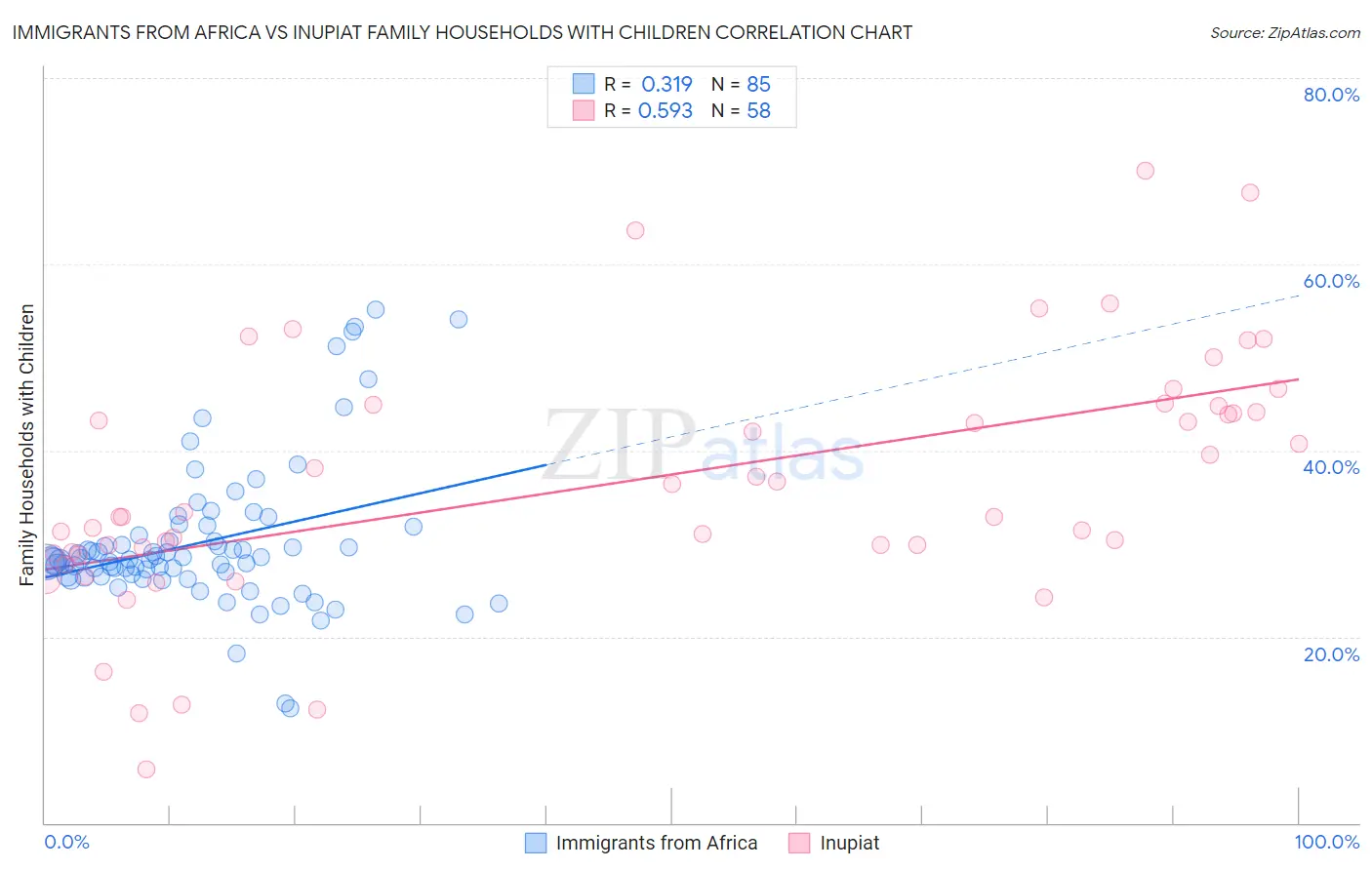Immigrants from Africa vs Inupiat Family Households with Children
COMPARE
Immigrants from Africa
Inupiat
Family Households with Children
Family Households with Children Comparison
Immigrants from Africa
Inupiat
28.0%
FAMILY HOUSEHOLDS WITH CHILDREN
96.8/ 100
METRIC RATING
115th/ 347
METRIC RANK
32.8%
FAMILY HOUSEHOLDS WITH CHILDREN
100/ 100
METRIC RATING
2nd/ 347
METRIC RANK
Immigrants from Africa vs Inupiat Family Households with Children Correlation Chart
The statistical analysis conducted on geographies consisting of 468,727,064 people shows a mild positive correlation between the proportion of Immigrants from Africa and percentage of family households with children in the United States with a correlation coefficient (R) of 0.319 and weighted average of 28.0%. Similarly, the statistical analysis conducted on geographies consisting of 96,318,609 people shows a substantial positive correlation between the proportion of Inupiat and percentage of family households with children in the United States with a correlation coefficient (R) of 0.593 and weighted average of 32.8%, a difference of 17.4%.

Family Households with Children Correlation Summary
| Measurement | Immigrants from Africa | Inupiat |
| Minimum | 12.2% | 5.8% |
| Maximum | 55.1% | 70.0% |
| Range | 42.9% | 64.2% |
| Mean | 30.1% | 36.6% |
| Median | 28.3% | 33.1% |
| Interquartile 25% (IQ1) | 26.5% | 29.1% |
| Interquartile 75% (IQ3) | 31.4% | 44.8% |
| Interquartile Range (IQR) | 4.9% | 15.7% |
| Standard Deviation (Sample) | 8.0% | 13.3% |
| Standard Deviation (Population) | 7.9% | 13.2% |
Similar Demographics by Family Households with Children
Demographics Similar to Immigrants from Africa by Family Households with Children
In terms of family households with children, the demographic groups most similar to Immigrants from Africa are South American Indian (28.0%, a difference of 0.010%), Arab (28.0%, a difference of 0.030%), Immigrants from Middle Africa (28.0%, a difference of 0.040%), Scandinavian (28.0%, a difference of 0.060%), and Spaniard (28.0%, a difference of 0.13%).
| Demographics | Rating | Rank | Family Households with Children |
| Immigrants | Burma/Myanmar | 97.7 /100 | #108 | Exceptional 28.0% |
| Tohono O'odham | 97.6 /100 | #109 | Exceptional 28.0% |
| Spaniards | 97.4 /100 | #110 | Exceptional 28.0% |
| Scandinavians | 97.1 /100 | #111 | Exceptional 28.0% |
| Immigrants | Middle Africa | 97.0 /100 | #112 | Exceptional 28.0% |
| Arabs | 97.0 /100 | #113 | Exceptional 28.0% |
| South American Indians | 96.9 /100 | #114 | Exceptional 28.0% |
| Immigrants | Africa | 96.8 /100 | #115 | Exceptional 28.0% |
| Pakistanis | 96.0 /100 | #116 | Exceptional 27.9% |
| Immigrants | Malaysia | 95.9 /100 | #117 | Exceptional 27.9% |
| Central American Indians | 95.9 /100 | #118 | Exceptional 27.9% |
| Zimbabweans | 95.6 /100 | #119 | Exceptional 27.9% |
| Europeans | 95.4 /100 | #120 | Exceptional 27.9% |
| Immigrants | Western Asia | 93.6 /100 | #121 | Exceptional 27.9% |
| Immigrants | Zimbabwe | 92.8 /100 | #122 | Exceptional 27.8% |
Demographics Similar to Inupiat by Family Households with Children
In terms of family households with children, the demographic groups most similar to Inupiat are Immigrants from Mexico (31.6%, a difference of 3.9%), Mexican (31.4%, a difference of 4.7%), Tongan (31.2%, a difference of 5.1%), Immigrants from India (31.0%, a difference of 5.8%), and Immigrants from Central America (31.0%, a difference of 6.1%).
| Demographics | Rating | Rank | Family Households with Children |
| Yup'ik | 100 /100 | #1 | Exceptional 37.0% |
| Inupiat | 100 /100 | #2 | Exceptional 32.8% |
| Immigrants | Mexico | 100.0 /100 | #3 | Exceptional 31.6% |
| Mexicans | 100.0 /100 | #4 | Exceptional 31.4% |
| Tongans | 100.0 /100 | #5 | Exceptional 31.2% |
| Immigrants | India | 100.0 /100 | #6 | Exceptional 31.0% |
| Immigrants | Central America | 100.0 /100 | #7 | Exceptional 31.0% |
| Yakama | 100.0 /100 | #8 | Exceptional 30.8% |
| Thais | 100.0 /100 | #9 | Exceptional 30.6% |
| Immigrants | Fiji | 100.0 /100 | #10 | Exceptional 30.5% |
| Nepalese | 100.0 /100 | #11 | Exceptional 30.5% |
| Immigrants | Pakistan | 100.0 /100 | #12 | Exceptional 30.2% |
| Afghans | 100.0 /100 | #13 | Exceptional 30.2% |
| Bangladeshis | 100.0 /100 | #14 | Exceptional 30.1% |
| Immigrants | South Central Asia | 100.0 /100 | #15 | Exceptional 30.0% |